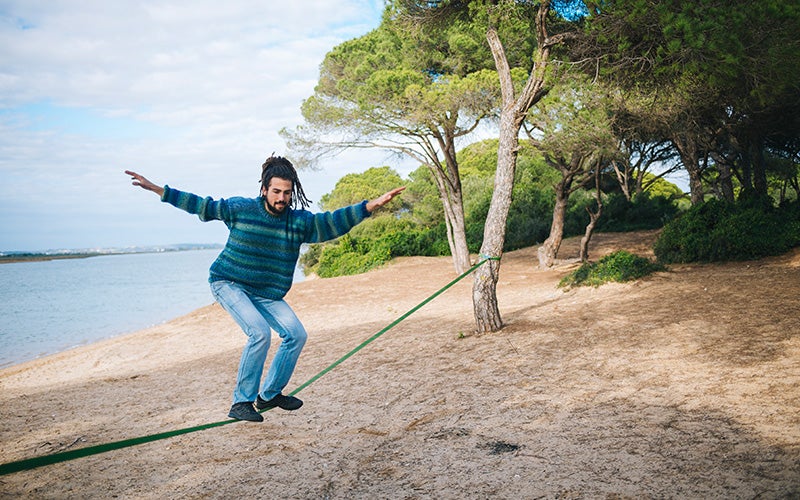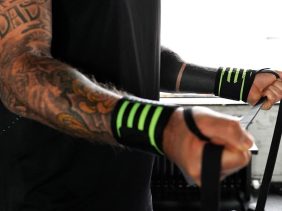5 ways to start with slackline – it’s harder than it looks!
 ©Morsa Images
©Morsa Images
Slackline could be the most popular activity in the recreational sports scene. The tensile rope is used to train your muscles, coordination, and concentration. Slacklining is an exciting and super trendy way to spend some time outdoors with kindred spirits. Lots of fun guaranteed! Let’s talk about how it works, what you need to get off the ground, and how to keep the excitement going.
What is slackline?
Slackline is a piece of training equipment that is used for slacking, also called slacklining. It involves balancing on a stretchy cord that is attached between two fixed points (like two trees, for example).
The more experienced you are at slacklining, the more tricky it can be to walk across the wobbly rope. While beginners try to stand on the slackline without any support, more advanced slackliners make their first attempts at walking forwards and backwards along the line. Real pros can do some really impressive tricks, like jumping, bouncing, and spinning, going from sitting to standing and back again, or even doing somersaults. You can use different types of slackline to cover different distances, balance over water, or set records at dizzying heights.
Typically, slacklining is practiced outdoors, like in a public park. It not only challenges your stability, but also your coordination and concentration. Not without reason, slacking is a popular complement to other sports that require a good sense of balance, such as climbing, parkour, martial arts, horseback riding, skiing, snowboarding, and longboarding. Plus: that it’s so communal and social is a major perk.
©Westend61
What exactly does slacklining do for you?
Do you remember getting up on the balance beam in school? Not so easy up there, but the challenge was exhilarating. Now imagine that the ground below you is also unstable. Interested? You should definitely try slacklining: the ultimate balance exercise.
These are some benefits of slacklining:
- You improve your sense of balance and body awareness.
- You train your concentration and coordination skills.
- You stabilize your joints.
- You can compensate for imbalances and prevent back pain and tightness.
- You improve your posture.
- You strengthen the deep muscles in the core and around the spine.
- You minimize the risk of injury in sports and everyday life.
- You maximize your performance.
Plus, you’ll be out in the fresh air a lot, which can do wonders for your mental health. Another bonus: training in a group is socially rewarding. Slacking is not a competitive sport that’s about who’s better or faster. Instead, it’s about pushing and supporting each other. This creates a sense of team spirit and can boost your self-confidence. Sounds like a winning combination.
What do you need for slackline?
The most important thing is, of course, the slackline itself! You’d be stranded without it! You also need to be able to securely attach it to trees or other fixed points (such as posts). To protect the tree trunks and/or the bark from damage, you should also use something called a tree protector.
What types of line are there?
Not all lines are created equal. There’s plenty of different lengths, widths, and textures, depending on how you’ll use it. Some of the more popular styles include:
- Low Line: This is the classic style, and is the most versatile of the slacklines, making it perfect for beginners. The line is attached at about knee height, which is suitable for first walking attempts and simple tricks.
- Jump Line: This type of slackline is characterized by its “trampoline effect”, and is especially well suited for trying out those jumping exercises.
- Long Line: Extra long slacklines can be used to cover distances of more than 30 meters.
- Highline: While the classic line is attached around knee height, highlines are suspended much higher. The sky’s your limit up there, and height gives you a greater variety of tricks to do. As a safety measure, you need to wear a safety harness similar to one you would use when rock climbing.
- Water Line: If the line is stretched over a body of water such as a river or stream, it’s called a water line.

Who should give it a try?
Slacklining knows no bounds! No matter your age or experience, this sport is for everybody. Absolute newbies on the slackline can get a kick out of it, just as much as bona fide balance fanatics.
It’s definitely an advantage if you already have good core stability. If yours is strong, you’ll find it a little easier to stay on the line. Targeted core workouts can support you here. Tip: Here are our top exercises for a powerful core!
Apart from that, you should have an interest in team or community sports. Slacking is really the most fun when done in a group. When playing around with like-minded people, you’ll get hands-on help, learn tricks from advanced athletes, and even make some interesting new friends.
Learning to slackline: tips for beginners
If you’re standing on a slackline for the first time, you might not think you’ll ever be able to walk across it, let alone try out a trick on it. Slacklining is a pretty shaky business. It could take a few sessions before you make much improvement. But don’t despair! Here are our tips for beginners:
- Start with a slackline that is as short (15m) and wide (5cm) as possible, and has a surface for extra good foot hold.
- Tension the line at a maximum of knee height at the beginning, so that you’ll be low to the ground and can easily climb up.
- Practice first with a partner who can assist you throughout.
- Practice climbing up first. Firmly place one foot on the line and push yourself up with a straight upper body. Tighten your abs in particular. Hold this position and then switch feet to work both sides evenly.
- When standing on the slackline, look straight ahead at a fixed point.
Practice standing on the slackline – that’s enough. This will improve your balance, help you internalize some basic techniques, and give you a good feel for the line, which will help you moving forward.
As a beginner, be patient with yourself, let your slack buddies help you, and just have fun!
Summary
- Slacklining is a recreational sport with its roots in climbing.
- It involves stretching a thin, tensile rope between two trees or other fixed points and balancing on it. This trendy activity is a great workout for your balance, coordination, and concentration.
- Slackline training mostly targets the core muscles, but also the glutes and legs.
- Slacklining requires great body awareness and solid engagement.
- It’s a creative and challenging sport for anyone who enjoys getting outdoors and having fun together.
Sources for this article
We at foodspring use only high-quality sources, including peer-reviewed studies, to support the facts within our articles. Read our editorial policy to learn more about how we fact-check and keep our content accurate, reliable, and trustworthy.























